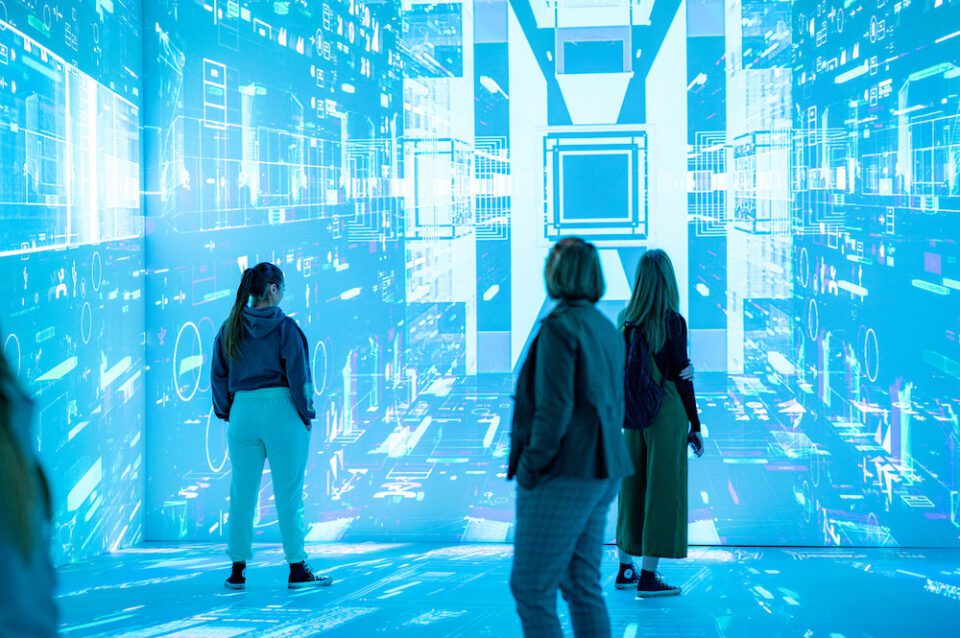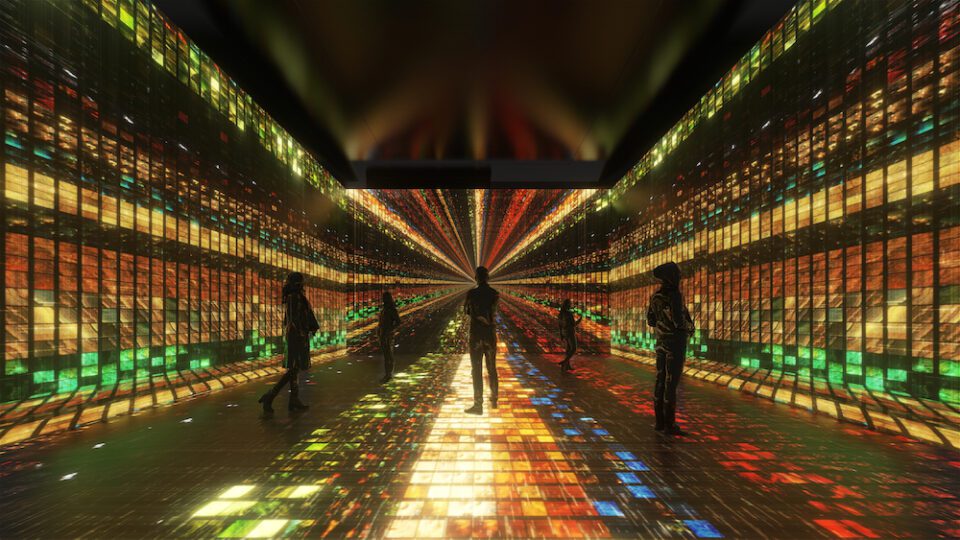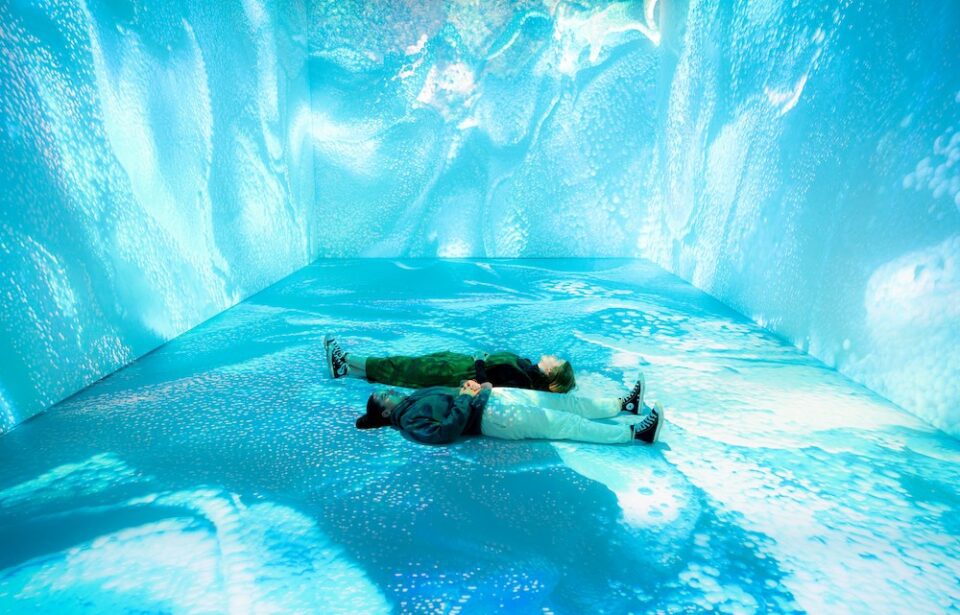Data is all around us. An estimated 2.5 quintillion bytes of data is created every day. It’s challenging to imagine this kind of scale, and, most of the time, digital information remains invisible to the human eye. Los Angeles-based Refik Anadol (b. 1985, Istanbul) is a pioneer in the aesthetics of machine intelligence. Partnering with the likes of Microsoft, Google and MIT, his practice turns data-driven machine learning algorithms into abstract, dreamlike environments. Through immersive installations and data sculptures, the artist transforms buildings, floors, walls and ceilings into breathtaking visual experiences. The goal: to offer a new perspective on the information that makes up our world.
Now, Machine Memoirs: Space – Istanbul’s most visited exhibition ever – comes to the UK. The product of a long-term collaboration with NASA, the exhibition uses artificial intelligence (AI) to reimagine two million publicly available images taken by satellites, telescopes and the International Space Station. The show marks the opening of the UK’s first permanent immersive digital gallery: The Reel Store in Coventry, a space for art at the intersections of science and technology.
A: Machine Memoirs: Space uses AI to reimagine visuals from NASA satellites, telescopes and the International Space Station. How did you come up with the idea, and when did your collaboration with NASA begin?
RA: We started working with NASA/JPL in 2008 on an incredible research project, so it’s been a 14-year journey using space data. I also started my journey with data paintings in 2008; that’s when I coined the term. For the last six years I have focused in on how to use big data in practice. The NASA/JPL collaboration is one of the most inspiring projects I have worked on. I love the idea of future experiences in relation to space – a fundamental sci-fi dream. That’s where the idea of dreaming about space with AI and machines came from. The focus was super simple: a machine in space which records humanity’s most important memories and uses them as pigmentation.

A: These are new digital interpretations of space which exist “only in the mind of the machine.” What does the computer do with the original photographs? How do the NASA images end up as immersive rooms?
RA: The idea of using built environments started almost 11 years ago. Since then, we have been creating immersive worlds where light becomes material with data – like the incredible Reel Store in Coventry, where the floor and the walls become one continuous canvas. To make this happen, we write custom algorithms and conduct graphics-based research, to enable millions of images to be processed by machines and then reconstructed as a narrative.
When you step into this world you will witness millions of images around you becoming a data tunnel. From the data tunnel, you will arrive in a place where AI reconstructs images based on similarities. From there, you will enter a dream state with an algorithm called GAN (Generative Adversarial Network). In addition, heavy computer graphics are used in the project, as well as computer graphic innovations. Essentially, you are entering the mind of a machine step by step: seeing the memory, learning the memory and then dreaming about the memory itself. At The Reel Store visitors will experience amazing sounds within a positive and inspiring environment.
A: How does this exhibition tie into your larger body of work? There are similarities here to Unsupervised – Machine Hallucinations, which generates mesmerising images in response to the Museum of Modern Art archive.
RA: There was a very similar approach taken to achieve Unsupervised – Machine Hallucinations. Our focus as a studio is to create well-aligned public art pieces for anyone, of any age, around the world. For this exhibition we have used a meaningful archive: the collective data of humanity. It’s very well-aligned with the future of what we do and the past of what we dream. It’s very exciting that this is a piece of public art created with public data. Our studio loves this form of communication. The innovation inside The Reel Store is significant. With Machine Memoirs: Space, audiences will be exposed to a huge amount of data and algorithms. I do believe that the installation and setup is at the forefront of a remarkable new art form.

A: AI art generators and design automation tools are becoming increasingly accessible online. How do you think these kinds of processes will influence human creativity going forward?
RA: I think this will be an incredible year. Six years ago when I started my journey there was pretty much nothing available. But, six years in AI is like 60 years in innovation! What I think is exciting now is OpenAI’s just-released DallE 2. Now, more than five billion parameters of AI can use a multi-model approach –meaning going from text to image is not a dream anymore. These machines are incredibly inspiring and will challenge creative minds. In the future, I think people will become the creators of creators, directors of directors, writers of writers. I think this era is coming. In this project, I’m very excited and happy to share what AI means for creativity and how it can be used for good.
A: The Reel Store follows on from the popularity of immersive spaces worldwide; it will be the UK’s first permanent digital art gallery. Why do you think these kinds of spaces are so enthralling? What will audiences experience at The Reel Store?
RA: The Reel Store will be a pioneering space where you can step inside “the idea” and experience it in full. Immersive concepts have been evolving since the 1970s, so the idea itself isn’t new. However, AI and data now have a huge role to play, and this addition makes it extremely fresh.
Also, cinema has been part of our lives for many decades and every cinematic creator has imagined creating new worlds. But now, creating worlds is not just a two-dimensional experience, it is a three-dimensional one – you can step in, feel it and touch it. This multi-sensory world is profoundly inspiring. It’s very timely now because of developments like blockchains, NFTs and the Metaverse.

A: You’ve described this project as offering “a hopeful future where machines and humanity, in combination, are agents for healing.” How do you see the relationship between art, technology and science developing? Can they come together to help build a “better” world?
RA: One hundred percent, yes. That is exactly what it is doing, especially after the pandemic. Humanity went through a heavy collective trauma, and right now we are witnessing the rise of hope and positivity again. This is a perfect time to talk about healing for the mind – I do believe we need this more than ever. Arts organisations like The Reel Store in Coventry will bring hope, wellbeing and healing for the community purely by using art, science and technology. I believe the cross-sections of these important mediums will make humanity much better.
Machine Memoirs: Space by Refik Anadol runs 18 May to 4 September at The Reel Store, the UK’s first permanent immersive digital art gallery, which opened in April as part of the Coventry UK City of Culture celebrations. coventry2021.co.uk
Words: Eleanor Sutherland
Image Credits:
1-3. Machine Memoirs: Space by Refik Anadol @ Coventry City of Culture’s The Reel Store. Photo Credit: Jamie Gray
4. Refik Anadol Studio





